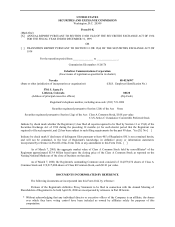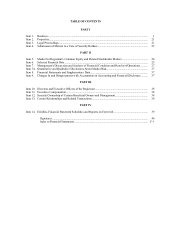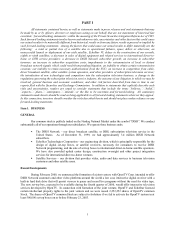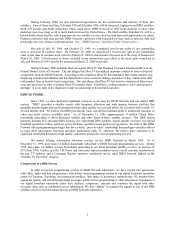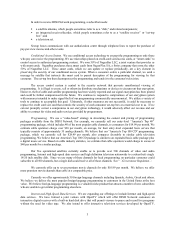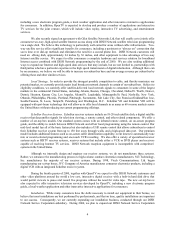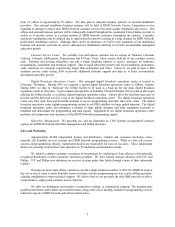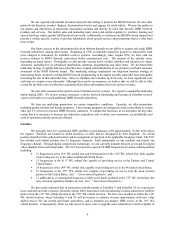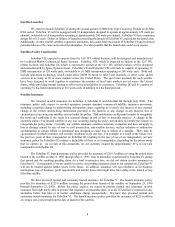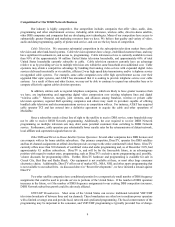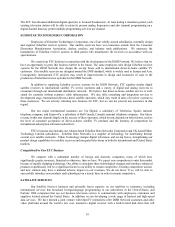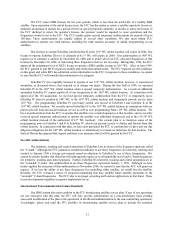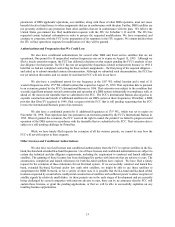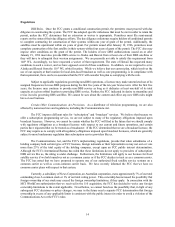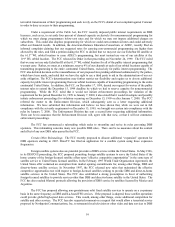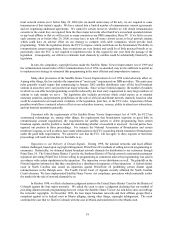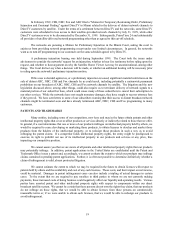Dish Network 1999 Annual Report Download - page 11
Download and view the complete annual report
Please find page 11 of the 1999 Dish Network annual report below. You can navigate through the pages in the report by either clicking on the pages listed below, or by using the keyword search tool below to find specific information within the annual report.9
Competition For Our DISH Network Business
Our industry is highly competitive. Our competition includes companies that offer video, audio, data,
programming and other entertainment services, including cable television, wireless cable, direct-to-home satellite,
other DBS companies and companies that are developing new technologies. Many of our competitors have access to
substantially greater financial and marketing resources than we have. We believe that quality and variety of video,
audio and data programming, quality of picture and service, and cost are the key bases of competition.
Cable Television. We encounter substantial competition in the subscription television market from cable
television and other land-based systems. Cable television operators have a large, established customer base, and may
have significant investments in, and access to, programming. Cable television service is currently available to more
than 90% of the approximately 99 million United States television households, and approximately 66% of total
United States households currently subscribe to cable. Cable television operators currently have an advantage
relative to us by providing service to multiple television sets within the same household at no additional cost. Cable
operators may obtain a competitive advantage by bundling their analog video service with expanded digital video
services delivered terrestrially or via satellite, efficient 2-way high speed data transmission, and/or telephone service
on upgraded cable systems. For example, some cable companies now offer high speed Internet access over their
upgraded fiber optic systems, and AT&T has announced that it is seeking to provide telephone service over cable
systems. As a result of these and other factors, we may not be able to continue to expand our subscriber base or to
compete effectively against cable television operators.
In addition, entities such as regional telephone companies, which are likely to have greater resources than
we have, are implementing and supporting digital video compression over existing telephone lines and digital
“wireless cable.” Moreover, mergers, joint ventures, and alliances among franchise, wireless or private cable
television operators, regional Bell operating companies and others may result in providers capable of offering
bundled cable television and telecommunications services in competition with us. For instance, AT&T has acquired
cable operator TCI and has entered into a definitive agreement to acquire the cable and other operations of
MediaOne.
Since a subscriber needs a direct line of sight to the satellite to receive DBS service, some households may
not be able to receive DISH Network programming. Additionally, the cost required to receive DISH Network
programming on multiple television sets may deter some potential customers from switching to DISH Network
service. Furthermore, cable operators pay substantially lower royalty rates for the retransmission of distant network,
local affiliate and superstation signals than we do.
Other DBS and Direct-to-Home Satellite System Operators. Several other companies have DBS licenses and
can compete with us for home satellite subscribers. Our primary competitor, DirecTV, operates five DBS satellites
and has 46 channel assignments at orbital slots that provide coverage to the entire continental United States. DirecTV
currently offers more than 300 channels of combined video and audio programming and, as of December 1999, had
approximately 8.1 million subscribers. DirecTV is, and will be for the foreseeable future, in an advantageous
position with regard to market entry, programming, such as DirecTV’s exclusive sports programming and, possibly,
volume discounts for programming offers. Further, DirecTV hardware and programming is available for sale in
Circuit City, Best Buy and Radio Shack. Our equipment is not available at these, or most other large consumer
electronics chains. Additionally, DirecTV offers out of market NFL, NBA, NHL and other sports programming that
is not available to our subscribers. As discussed above in “Recent Developments”, we have initiated a lawsuit against
DirecTV.
Two other satellite companies have conditional permits for a comparatively small number of DBS frequency
assignments that could be used to provide service to portions of the United States. If the number of DBS operators
increases in the future, or if the number of DBS frequency assignments to our existing DBS competitors increases,
DISH Network subscriber growth could be adversely affected.
VHF/UHF Broadcasters. Most areas of the United States can receive traditional terrestrial VHF/UHF
television broadcasts of between three and ten channels. These broadcasters are often low to medium power operators
with a limited coverage area and provide local, network and syndicated programming. The local content nature of the
programming may be important to the consumer, and VHF/UHF programming is typically provided free of charge.

